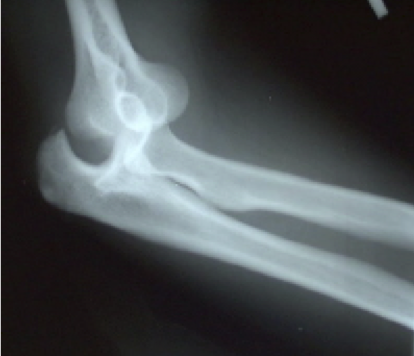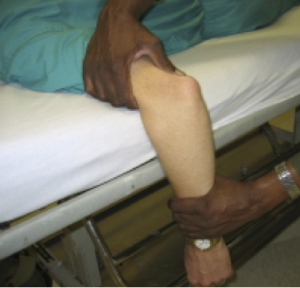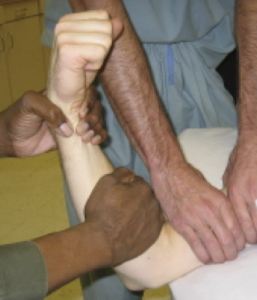Thanks to Dr. Caputo for today’s Morning Report!
ELBOW DISLOCATION
Background
Elbow dislocation: MC dislocation in children; in adults: 2nd MC second most common dislocation after that of the shoulder. Considerable force is necessary to dislocate the elbow; sports activities account for up to 50% of elbow dislocations
Posterior elbow dislocations: over 90% of elbow injuries. Given force, associated fractures are not infrequent
In the pediatric population, radial head subluxation is the main cause of elbow dislocations.
Stability: Bony with ligament back up (MCL, LCL) stability.
Compartments: The 2 main compartments of the elbow are the anterior and posterior compartments. The anterior compartment contains the brachial artery and the ulnar and median nerves. This compartment is more commonly affected by dislocations.
The ulnar nerve passes posteriorly to the medial epicondyle of the humerus, and then it travels deep in the forearm before becoming more superficial again at the wrist. The close proximity of the ulnar nerve to the medial epicondyle allows for the increased likelihood of entrapment when a dislocation occurs. The median nerve is also frequently affected and travels intimately with the brachial artery, which predisposes to simultaneous injury for both the artery and nerve. The posterior compartment contains the radial nerve and triceps brachii muscle.
Nursemaids elbow: In cases in which there is radial head subluxation, the radial head slips under the annular ligament and becomes trapped.
History
In posterior elbow dislocations, the patient often describes falling on an outstretched hand (ie, the FOOSH injury)
Anterior dislocations are usually the result of a direct posterior blow to a flexed elbow. Associated fractures of the olecranon are commonly seen.
Physical
Neurovascular assessment : Brachial Artery
Posterior elbow dislocations often have a very prominent olecranon and a forearm that appears foreshortened.
Anterior elbow dislocations have the appearance of an elongated forearm, and the arm is held in extension.
Sensation and Motor Assessment of Forearm nerves
The median nerve may also be injured or entrapped during a reduction.
Associated fractures: radial head or neck (5-10%), medial/lateral epicondyle avulsions (10%), those of the coronoid process (10%), and fractures of the distal radius, ulna, and proximal humerus (10%).
Compartment syndrome: may develop in the forearm fascia or biceps tendon due to massive swelling
Surgical Intervention
Seek surgical intervention by an orthopedist if any signs of neurovascular compromise, associated fractures, or nonreducible dislocations are present.
Consultations
Obtain orthopedic consultation if any signs of neurovascular compromise, associated fractures, or nonreducible dislocations are present.
Reduction Techniques:
Prone (one-person) technique
Position patient prone as described above.
Correct any medial or lateral translation of the proximal ulna.
Grab wrist of injured arm. Apply traction and slight supination to forearm.
Attempt to distract and unlock the coronoid process from the olecranon fossa.
Using the other hand, apply pressure to the posterior aspect of the olecranon while the arm is pronated
Prone (two-person) technique
Assistant encircles the humerus with both hands and apply pressure with the thumbs to the posterior aspect.
Apply longitudinal traction to the arm in flexion
Traditional traction (supine approach)
Position patient supine on the stretcher.
Have an assistant stabilize the humerus against the stretcher with both hands.
Grasp the wrist and apply slow, steady, inline traction, keeping the elbow slightly flexed and the wrist supinated
Splint: A posterior long-arm splint should be applied to the ulnar surface of the successfully reduced arm. The splint should also be secured such that the elbow is maintained at 90 degrees of flexion and the forearm is positioned neutral to pronation and supination. The metacarpophalangeal joints should be free to flex.
Prognosis:
Approximately 50% of patients with dislocated elbows achieve a full recovery, including full ROM. One third of patients experience some limitation of motion at the elbow, usually less than 10° of compromised motion. The remaining 10-15% of patients have more significant losses in function, primarily related to limited ROM.
Jay Khadpe MD
Latest posts by Jay Khadpe MD (see all)
- Morning Report: 7/30/2015 - July 30, 2015
- Morning Report: 7/28/2015 - July 28, 2015
- IN THE STRETCHER INSTEAD OF BESIDE IT - July 22, 2015
- Morning Report: 7/14/2015 - July 14, 2015
- Morning Report: 7/10/2015 - July 10, 2015





